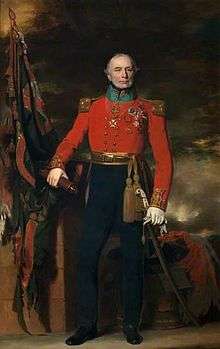Neil Douglas
Lieutenant-General Sir Neil Douglas KCB KCH (1779 – 1 September 1853) was a British Army officer who fought at the 1815 Battle of Waterloo and later became Commander-in-Chief, Scotland.
Sir Neil Douglas | |
|---|---|
 Sir Neil Douglas | |
| Born | 1779 |
| Died | 1 September 1853 |
| Allegiance | |
| Service/ | |
| Rank | Lieutenant-General |
| Commands held | Commander-in-Chief, Scotland |
| Battles/wars | Napoleonic Wars |
| Awards | Knight Commander of the Order of the Bath Knight Commander of the Royal Guelphic Order |
Military career
Douglas was commissioned into the 95th Regiment of Foot on 28 January 1801.[1] Promoted to captain in the 79th Regiment of Foot on 19 April 1804, he took part in the Battle of Copenhagen in August 1807, the Battle of Corunna in January 1809 and Battle of Bussaco in September 1810 during the Napoleonic Wars.[1] He went on to fight in the Battle of Nivelle in November 1813, the Battle of the Nive in December 1813 and the Battle of Toulouse in April 1814.[1] Promoted to lieutenant-colonel on 3 December 1812, he commanded his regiment at the Battle of Quatre Bras in June 1815 and the Battle of Waterloo also in June 1815 during the Hundred Days.[1]
He served as Commander-in-Chief, Scotland[2][3] and also as Governor of Edinburgh Castle from 1842[4] to 1847.[1]
Family
He married in 1816, Barbara, daughter of George Robertson, a banker of Greenock. They had a son, General Sir John Douglas of Glenfinart GCB (7 July 1817 – 8 September 1888), a British Army officer who became Commander-in-Chief, Scotland.[5]
References
- "Neil Douglas". Oxford Dictionary of National Biography. Retrieved 29 October 2014.
- "Dalry Cemetery". Edinburgh City Council. Retrieved 29 November 2014.
- "The Gentleman's Magazine, Volume 174". p. 540. Retrieved 29 November 2014.
- "No. 20095". The London Gazette. 29 April 1842. p. 1172.
- Great Britain. Army. Queen's Own Cameron Highlanders; Mackenzie, Thomas Arthur; Ewart, John Spencer; Jameson, Robert (1887). Historical records of the 79th Queen's Own Cameron Highlanders. University of California Libraries. London, Hamilton, Adams.
| Military offices | ||
|---|---|---|
| Preceded by Lord Greenock |
Commander-in-Chief, Scotland 1842–1847 |
Succeeded by Henry Riddell |
| Governor of Edinburgh Castle 1842–1847 | ||
| Preceded by Paul Anderson |
Colonel of the 78th (Highlanders) Regiment of Foot 1851–1853 |
Succeeded by Sir William Chalmers |
| Preceded by Sir Colin Campbell |
Colonel of the 72nd Regiment, Duke of Albany's Own Highlanders 1847–1851 |
Succeeded by John Aitchison |
| Preceded by Sir George Henry Frederick Berkeley |
Colonel of the 81st Regiment of Foot (Loyal Lincoln Volunteers) 1845–1847 |
Succeeded by Thomas Evans |